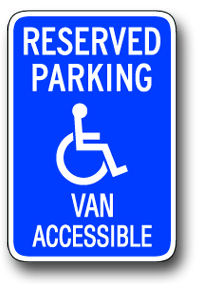
The federal government has set up certain requirements that must be fulfilled in order to set up traffic signs on your premises. The Americans with Disabilities Act (ADA) states that all signs must meet certain standards in regard to reflectivity, design, size, mounting, and height. These requirements should be fulfilled to enable all disabled road users to receive consistent messages regardless of where they travel.
Where should ADA signs be posted? The Federal Highway Administration (FHWA) amended certain codes in the US to clarify how ADA signs should be displayed on all roads and parking lots. You are required to implement the amendment for all Manual on Uniform Traffic Control Devices to all roads accessible to the public on your premises. Thus, if your roads are open to the public, you should conform to all the federal regulations—even if they are roads on private property.
Displaying your ADA signs correctly will promote safety for both motorists and pedestrians. It’s important that road signs on your organization’s property adhere to all guidelines to avoid being held liable for any accidents and injuries that may happen on your property. All signs and posts should be ordered from experienced and legitimate suppliers like Zumar Industries. Reputable suppliers will always provide you with signs that are compliant with all federal codes and regulations.
Sign requirements. ADA signs, including pavement markings, should be visible to avoid confusion and promote safety for all visitors, employees, and the public. Vis-Z-Shield® is used to increase the reflectivity of your signs by utilizing a three-sided reflector on the post that alerts drivers of specific ADA related traffic instructions from all directions.
All ADA signs must be mounted on FHWA-approved perforated square steel posts to make them outstanding on the roadside. These posts are installed at an optimum height that enables all drivers, regardless of vehicle, to see them clearly. For indoor signs, those identifying rooms and spaces should be located adjacent to the door. They must also have non-glare characters and backgrounds.
Some outside signage applications include:
- identifying parking spaces
- indicating wider walkways
- highlighting passenger loading zones
- designating entrances and exits
- noting rescue assistance areas
- providing directions to the nearest accessible facility
The indoor ADA signs must have a great dark-to-light contrast between the background and the characters for clarity purposes. The difference enables even visually-impaired individuals to read the signs easily. Additionally, the directional and informational signs should use the simple upper and lower case letters for quick and easy readability.
To learn more about standards related to ADA signs, please visit the Americans with Disabilities website, or call the Zumar location nearest you.